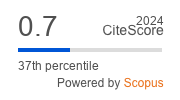Evaluation of bactericidal and anti-biofilm activities of silver nanoparticles against multidrug-resistant Gram-negative bacilli isolated from burn wound infections
DOI:
https://doi.org/10.47723/kcmj.v14i1.23Keywords:
Burn wound infections, Silver nanoparticles,, Anti-bactericidal,, Anti-biofilm,, Gram-negative bacilliAbstract
Background: The emergence and spread of multidrug-resistant Gram-negative bacilliin burn wound infections related to biofilm formation, which lend to challenge in treatment with conventional antibiotics andprompting to search for novel antimicrobial agents to control the infections.Silver nanoparticles (AgNPs) have wide spectrum biological properties with different mechanisms of action and less toxicity towards human cells.
Objective:The goal of this study was to evaluated the anti-bacterial and anti-biofilm activities of AgNPs alone and in combination with aminoglycoside (Amikacin) and β-lactam (Ampicillin) antibiotics against multidrug resistant Gram-negative bacilli (Pseudomonas aeruginosa, Escherichia coli, klebsiellapneumoniae) isolated from burn wound infections. Type of the study: Cross –sectional study.
Methods: 70 clinical isolates of GNBtested for susceptibility tests by disk diffusion method against 10 antibiotics. The minimum inhibitory concentrations (MICs) of AgNPs and antibiotics were carried out according to the standard broth microdilution method, while synergistic interactions were evaluated by time kill-kinetic assays. Calgary method was applied for anti-biofilm activity.
Results:Pseudomonas aeruginosa represented the majority of GNBisolated from burn wound infections 34 (48.5 %)followed by Klebsiella pneumonia 21 (30 %) and Escherichia coli 15 (21.5 %). Silver nanoparticles showed remarkable antibacterial activity against GNB that isolated from burn wound infections with the MICs between 25- 75 µg/ml. Aztreonam, amikacin and cefepime were the most effective antimicrobial drugagainst GNB isolates.Synergistic bactericidal effects were observed in two-drug combinations of AgNPswith broad-spectrum aminoglycoside (Amikacin) and β-lactam (Ampicillin) antibiotics against multidrug resistant GNB. In addition,AgNPsalone or in combination with ampicillin inhibited biofilm activity about 60 % – 75 % ofGNB,while combination of AgNPs withamikacin exhibited a powerful anti-biofilm activity and inhibition biofilm formation by 75% to 80%.
Conclusion: The results confirmed a synergistic bactericidal effects and significant enhancing of anti-biofilm activity of AgNPs in combination with antibiotics (amikacin and ampicillin) against multidrug resistant GNB isolated from burn wound infections. These data suggest that AgNPs could beapplied as nanodrug for treatment of burn wound infections













